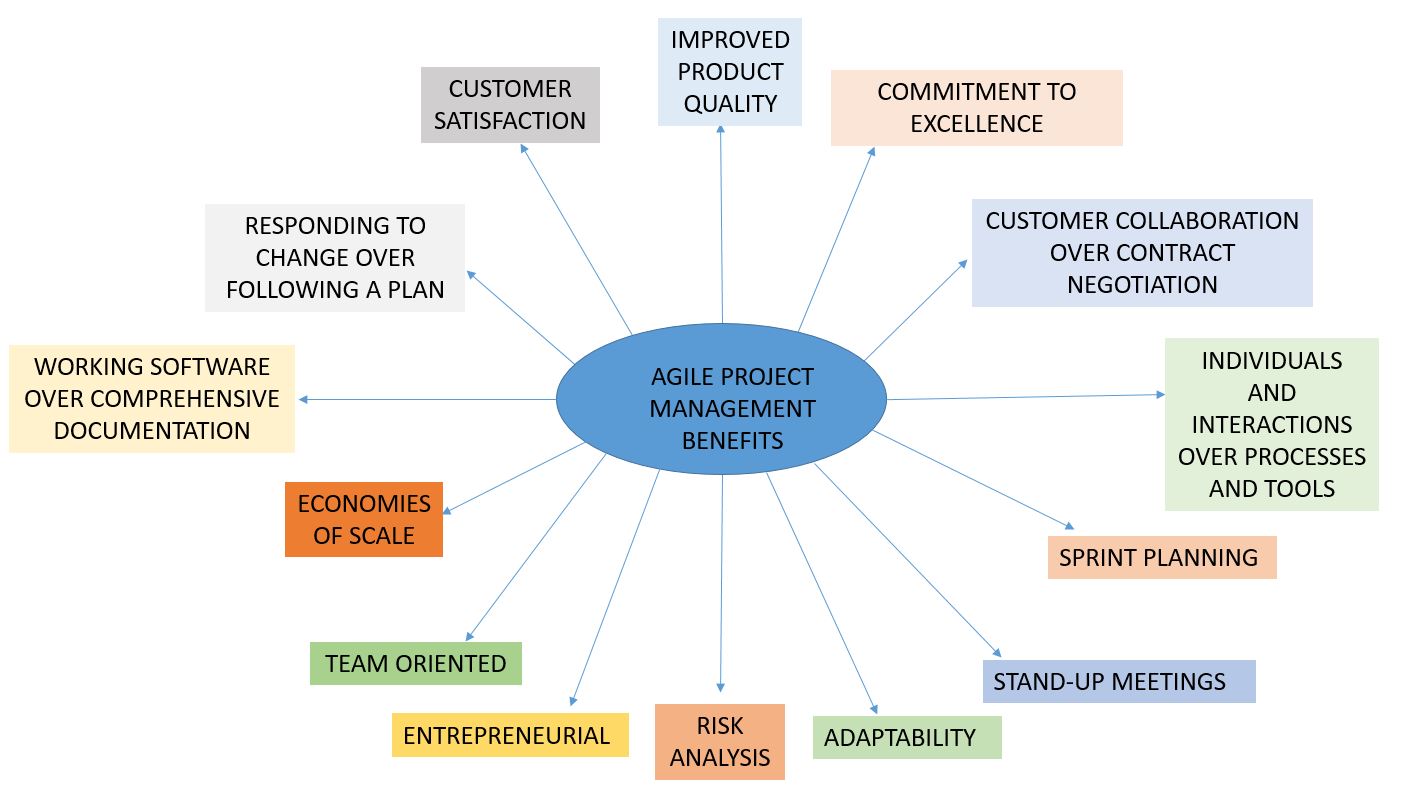
In software development, agile methodologies involve finding out requirements and developing solutions through the team’s combined effort and customers. It includes adaptive planning, evolutionary development, early delivery, and continual improvement, and it encourages flexible responses to change. In this blog, we are going to look into the benefits of agile project management.
Benefits of Agile Project Management
Improved Product Quality
Since there are continuous updates after every iteration, there is always a scope for improving the product quality. The merchandise owner’s role is to define every sprint’s goals, manage and give importance to the team backlog, and be the voice of the customer or internal stakeholder.
The quality of a product can be measured by the number of defects that are pushed to the client or found in production and the number of users it impacts. The key to a good quality product is to ensure that defects are not released to production.
Customer Satisfaction
Given the improvement of the product quality, there is higher customer satisfaction. There is also scope to add any changes that the customer may suggest from time to time during the product development. Therefore, the team can produce an inexpensive estimate of the trouble needed to complete the task. This is written from the user’s perspective and focuses on outlining what your client wants and why.
Risk Analysis
An Agile implementation reduces the chances of the product delivering lower output or failing. This is one of the most important benefits of Agile project management as it helps to deliver value to the customers faster and with fewer issues. Instead of releasing the product on a launch all at a time, an agile team delivers work in small but consumable increments. This also helps the team to take calculated steps to avoid any risk during the project implementation.
This is one of the most important benefits of Agile project management that eliminates the chances of absolute project failure. Since the project is developed in sprints, ensuring a short time between initial project investment and either failing fast or knowing that a product or an approach will work.
Economies of Scale
The customer bears substantial benefits of improved product quality that delivers better output from time to time, giving better profit margins. One of the benefits of agile project management is delivering quality output quicker.
For example, creating new software allows the firm to target profitable market niches. Large shipping companies cut costs by using larger vessels. Finally, large companies achieve technical economies of scale because they learn by doing. This is where agile project management excels.
Individuals and Interactions Over Processes and Tools
Relying too heavily on automated methods results in an inability to adapt to changing circumstances. Human intervention is preferable any day for improvising the project product quality after every iteration.
There is a very high capital expenditure required to invest in automation, it also needs higher maintenance with an increase in complexity and a generally lower degree of flexibility when compared with human intervention.
Working Software Over Comprehensive Documentation
Working software is as essential as documentation. This value gives the developers exactly what they need to get the job done without overloading them. The conventional approach to gathering all the customer requirements at the beginning of the project and plan other phases involves spending months writing requirements, design, analysis, and test case documents. Eventually, these documents will be out of date.
This means to create a document that provides value to the team and should not stop the team’s progress towards development. Most of the time, the team will create a system design document that is not required during this development phase. The team previously used to waste time documenting data that they are not going to use. So the team spent time writing the documents which will delay the development timeline. This, in turn, increases the budget cost.
Customer Collaboration Over Contract Negotiation
Customers are one of the most crucial parts of the project and can help us make sure that the top product meets their needs more effectively. The product owner plays the key role here.
The need for changes in the requirements is minimized. For example, while documenting project requirements, the Product Owner collaborates with stakeholders to create the Project requirements. This ensures there is clarity among Scrum Core Team members on the work that is required to complete the project.
Responding to Change Over Following a Plan
This value is one of the most critical components in the lifetime of any given project. Each sprint provides a chance for review and course correction. The project team tries to meet the deadline at the mid-stage of the project while the business team starts planning the next project. This practice leads to working on assumptions and delivering the project inaccurately. The project team blindly follows the plan and misses the opportunity to create a valuable product.
This is avoided in agile project management as instead of sticking to the plan, the focus is more on making the necessary changes wherever possible to improve the quality of the product.
Sprint Planning
Sprints are small iterations that usually take up to three weeks to complete, where teams work on blocks of tasks determined in the sprint planning meeting. As you progress forward, the thought is to repeat these sprints until your product is ready continuously. Once the sprint is completed, you review the merchandise. See what is and isn’t working and make adjustments. After this, start another sprint to enhance the merchandise or service. Let us suppose, during a sprint work is done to add new features based on the user stories and backlog a new Sprint only starts immediately after the current sprint ends.
Stand-up Meetings
Daily stand-up meetings (under 10 minutes), also referred to as daily Scrum meetings, are an excellent way of ensuring most are on target and informed. These daily meetings are called “stand up” as the participants are required to stay standing, helping to keep the meetings brief and to the point.
These meetings mostly emphasize the following pointers
- What was accomplished yesterday by each employee or the team in general?
- They will discuss what the employees or the team will accomplish today?
- What issues may impede the progress of each employee or the team?
Adaptability
Adaptability refers to the employee or team doing things in order to suit a new situation. Each team member knows how to use the skill set and use it, whatever the environment. Given the technological advances in software development, adapting to changes, and making updates to the product is a very critical aspect to give the best quality output.
Entrepreneurial
An Agile team member doesn’t wait to be told what has to be done. They step up and work where they see a requirement. This sense of entrepreneurial trait is crucial as it reduces the need for the managers to keep monitoring the team members. This sense of accountability also ensures in increasing the efficiency of the team performance.
Team-oriented
The people in any team are those who execute each sprint. Each team consists of usually three to seven people who have various specialties and strengths. Or, teams of individuals with an equivalent job role. Team members give importance to the success of the team over their personal glory. If most team members are performing well, they see that as a win.
Team Oriented work culture ensures proper sharing of information with all the team members in aim, policies, and decisions. Clear informed team members contribute better in every situation and feedback to reach the goal.
Commitment to Excellence
One of the benefits of Agile project management is delivering quality output quicker. Team members who seek excellence don’t settle for average but are dedicated to always producing their best work.
To be excellent as a team, there must be a consistent focus on improving and providing better quality after each sprint. A commitment to excellence is the first step to continuous improvement. The entire team must embrace the continuous improvement approach.
Transitioning to Agile Project Management
Transitioning into Agile will start by training your Agile teams on how they will move into their new roles, begin having daily meetings, and move their current project to the Agile methodology. Tracking a new Agile team’s progress will be very beneficial to give them confidence in the changes helping them understand the benefits of Agile Project Management.
Here are a few things that can help for an agile transition:
- Check Team Capacity: Calculate the team capacity and take into account the billable hours to ensure there is enough margin to make up for any unexpected spike in workloads during the period of the project
- Individual Capacity: Plan each person’s workload to help accommodate any changing project requirements while also maintaining your team’s efficiency
- Estimation: A key part of successful sprint planning is estimating task complexity. This will help to build the team consensus on how to execute each sprint’s required deliverables
- Sprint length: The sprint lengths have to be adjusted as per the requirement until a plan for something that works for all project stakeholders is designed
Conclusion
Agile methodology has its fair share of disadvantages like project getting side-tracked once in a while and difficulty implementing long-term projects. But still, at the end of the day, the benefits of agile project management outweigh the drawbacks of customer satisfaction and product quality matter. This is the best method to implement for any short or medium-term projects.

















